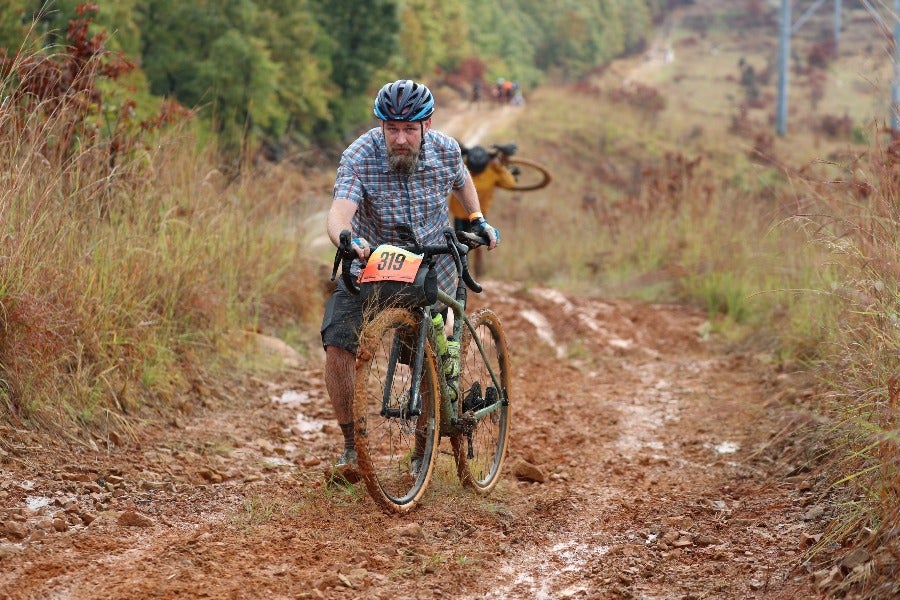For many of the patients Anthony Haney, M.D., a cardiologist with Oklahoma Heart Institute, treats, he recommends various methods of physical exercise in order to improve their health.
“A lot of times, patients will ask me what I do,” Haney said. “I’ll go into what I do and how it’s benefited me.”
Haney’s exercise of choice is cycling. More specifically, it’s gravel cycling, also known as gravel riding or gravel biking. As the name would suggest, gravel riding involves getting on a bicycle and riding on dirt and gravel paths. But his version of gravel riding requires more than just a casual stroll down a beaten path.
Haney competed in five century races in 2021. To qualify as a century racer, a cyclist must ride in events either 100 miles or 100 kilometers (62.1 miles) in length.
“What I really like about gravel cycling is it’s like back to being a kid and riding your BMX bike around,” Haney said.
Depending on the conditions, gravel races can last longer than a shift at the hospital. Physical and mental stamina are a must.
That’s just fine with Haney.
“The fitness, it keeps me in shape,” he said. “I get to spend a day where I’m outdoors and there’s the challenge. It’s not easy.”
Growing up, Haney and his father rode around Fort Sill Army Base in his hometown of Lawton. In high school, the younger Haney was riding on Mount Scott, located on the eastern edge of the Wichita Mountains Wildlife Refuge, when he fell off his bike and broke his collarbone. The injury, known as one of the most common for cyclists, put a halt on his biking career at the time.
In July 2019, Haney bought a Peloton. After carving out a regular regiment on the stationary bike, he purchased a road bike as well.
“I was riding about every day on the Peloton, so I figured, ‘Why not?’” Haney said.
Haney built up his strength and stamina by continuing to put the miles in on both bikes. In March 2021, he entered is first gravel race, the Mid-South in Stillwater, which turned out to be a memorable adventure.
“The Mid-South is a big ride,” said Haney, who rode in the 100-mile race. “There are 1,000s of riders that come.”
Rain covered the area the day before, leaving the course terrain like “peanut butter,” according to Haney.
“It was hard to run your tires through it,” he said.
Instead, Haney was forced to walk his bike through several miles of the course. The race, which began at 9 a.m., lasted more than 11 hours for Haney.
“I didn’t think the race would finish in the dark, so I didn’t have any lights on my bike,” Haney said. “There were a couple of guys from Tulsa in the race, too. I got close to them at the end. One of them had a headlight and the other had a taillight, so I got my bike in between theirs and we were in good shape to finish.”
Haney also rode in the Big Sugar Gravel in Bentonville, Arkansas, a race that included an unusual pit stop.
“One of the stops was a brewery in Bentonville,” he said. “Seventy miles into the race, I had a drink with a pig. That was pretty memorable.”
Haney, who considers himself a casual gravel cyclist, plans to continue riding in 2022 and beyond.
“There is a small group of people that are competitive and obviously there can only be one winner,” he said. “There’s a much bigger group of people that are more casual and out there for the experience, the exercise, the community.”
Haney said gravel cycling provides a change of pace from his typical day-to-day routine.
“If you spend seven or eight hours on a bike, you have a lot of time to think,” he said. “For me it’s a good way to manage stress. The exercise is a way to reset, refresh from a busy work week. And that experience with nature is important to me. One of the fun things about gravel is finding your own routes, going out and exploring down the dirt roads and finding things that are unique. That’s what will keep you coming back.”

